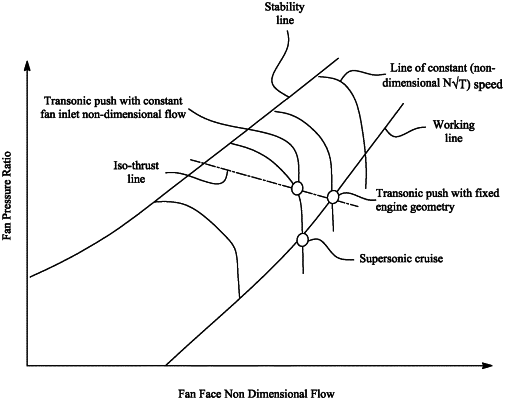| CPC B64D 33/02 (2013.01) [B64C 30/00 (2013.01); F02C 7/04 (2013.01); F02K 1/08 (2013.01); B64D 2033/026 (2013.01); B64D 2033/0286 (2013.01); F02K 1/386 (2013.01); F02K 3/075 (2013.01); F05D 2220/80 (2013.01); F05D 2250/51 (2013.01)] | 7 Claims |

|
7. A method of operating a supersonic aircraft having a turbofan engine which provides propulsive thrust to the aircraft over a range of flight operations including a transonic push operation during which the aircraft transitions from subsonic to supersonic flight and a supersonic cruise operation, the engine having:
an engine core comprising in flow series a compressor, a combustor and a turbine;
a fan located upstream of the engine core;
a supersonic intake for slowing down incoming air to subsonic velocities at an inlet to the fan formed by the intake;
a bypass duct surrounding the engine core, wherein the fan generates a core airflow to the engine core and a bypass airflow through the bypass duct;
a mixer for mixing an exhaust gas flow exiting the engine core and the bypass airflow exiting the bypass duct; and
a thrust nozzle rearwards of the mixer for discharging the mixed flows;
the method including:
performing a transonic push operation on the aircraft, the engine providing propulsive thrust during that operation; and
transitioning the aircraft after the transonic push operation to supersonic cruise operation and lowering the engine thrust by varying an area of a variable area throat of the thrust nozzle or adjusting one or more components which vary the relative areas available for the hot exhaust gas flow and the cold bypass airflow at the mixer while holding the fan inlet non-dimensional mass flow w√T/P substantially constant, where w is the mass flow of the incoming air at the fan inlet, T is stagnation temperature of the incoming air at the fan inlet and P is stagnation pressure of the incoming air at the fan inlet.
|